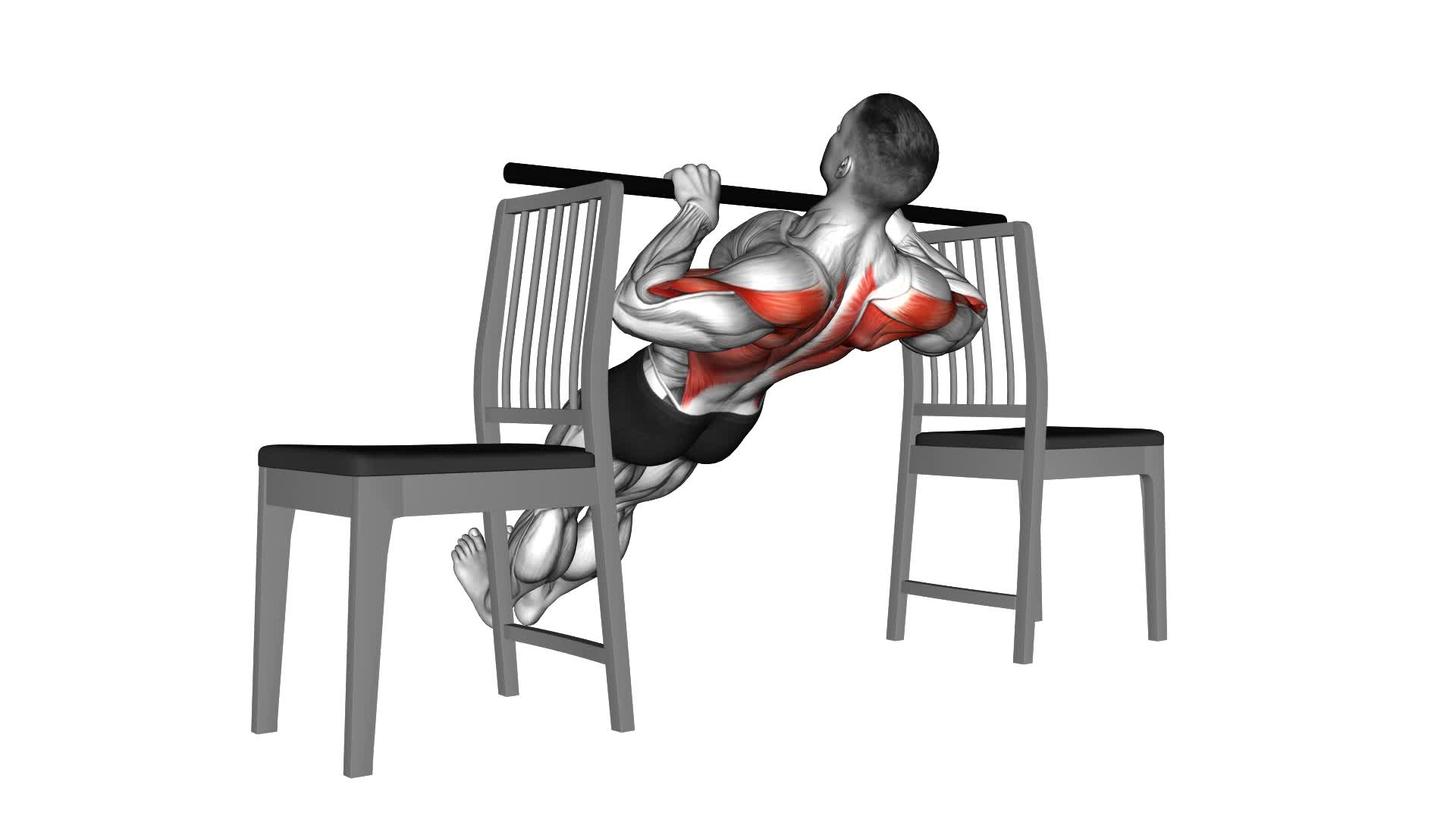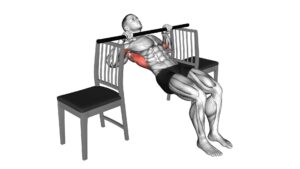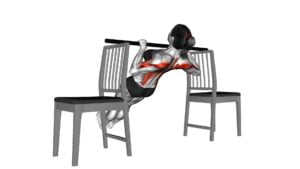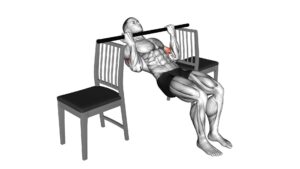Inverted Row Between Chairs – Video Exercise Guide & Tips

Looking to strengthen your upper body without fancy equipment? The inverted row between chairs is a versatile exercise that targets your back, arms, and core.
Watch This Exercise Video
In this video exercise guide, you'll learn the proper form and technique, as well as modifications and progressions to challenge yourself as you get stronger.
Avoid common mistakes and maximize your results with these tips.
Get ready to work those muscles and achieve your fitness goals!
Key Takeaways
- The inverted row targets multiple muscle groups including the back, biceps, and core.
- It improves posture and upper back strength.
- The exercise activates back muscles effectively.
- It is a compound exercise that can lead to increased strength gains.
Benefits of the Inverted Row
You can experience numerous benefits from incorporating the inverted row into your workout routine. This exercise is great for muscle activation and strength gains. By performing inverted rows, you engage multiple muscle groups, including your back, biceps, and core. This exercise helps to improve your posture by strengthening your upper back muscles and promoting better alignment. In addition, the inverted row targets your biceps, helping to build arm strength and definition.
One of the main benefits of the inverted row is its ability to activate your back muscles effectively. This exercise targets the muscles in your upper back, such as the latissimus dorsi, rhomboids, and trapezius. By strengthening these muscles, you can improve your overall posture and reduce the risk of back pain.
Furthermore, the inverted row is a compound exercise, meaning it works multiple muscle groups at the same time. This leads to increased strength gains throughout your upper body. By consistently incorporating inverted rows into your workout routine, you can build strength in your back, arms, and core.
Equipment and Setup
To set up for the inverted row between chairs, gather two sturdy chairs. Make sure the chairs are stable and can support your weight. You'll also need a bar or a broomstick that's long enough to stretch across the chairs. This will serve as your grip for the exercise.
When setting up the chairs, place them parallel to each other and about shoulder-width apart. The backs of the chairs should be facing each other. Make sure they're on a stable surface and won't slide or tip over during the exercise.
Next, position yourself between the chairs, facing up towards the ceiling. Grab the bar or broomstick with an overhand grip, slightly wider than shoulder-width apart. Your arms should be fully extended.
Now, lift your feet off the ground and straighten your body so that you're in a straight line from head to toe. Keep your core engaged and your glutes squeezed to maintain stability throughout the exercise.
You are now ready to perform the inverted row between chairs.
Proper Form and Technique
Maintain proper form and technique by keeping your body in a straight line and engaging your core and glutes throughout the inverted row between chairs. This exercise not only targets your back muscles but also engages your core, glutes, and arms.
One important aspect of proper form is scapular retraction, which involves pulling your shoulder blades back and down towards your spine. This helps to activate the muscles in your upper back and promotes a healthy shoulder position.
To ensure scapular retraction, imagine squeezing a pencil between your shoulder blades as you pull your chest towards the chairs. This will help you maintain a strong and stable upper body position throughout the exercise. In addition to scapular retraction, it's important to keep your body in a straight line from your head to your heels. Avoid arching or sagging your back, as this can put unnecessary strain on your spine.
By maintaining proper form and technique, you'll effectively target the muscles involved in inverted rows, including your latissimus dorsi (back muscles), rhomboids (upper back), biceps, and rear deltoids (shoulders). Engaging your core and glutes throughout the exercise will also help to stabilize your body and prevent any excessive movement.
Now that you understand the importance of proper form and technique, let's move on to the next section, which covers modifications and progressions to challenge yourself further.
Modifications and Progressions
To progress the inverted row between chairs exercise, you can increase the difficulty by using elevated surfaces or adding weight. Here are some progression options and modified variations to challenge yourself and continue improving:
- Elevated Surfaces:
Use a higher surface, such as a sturdy table or bar, to increase the angle of your body. This will require more strength from your back and arms.
Elevate your feet on a stable platform, like a bench or step, to add an extra challenge for your upper body.
- Adding Weight:
Place a weight plate or a dumbbell on your chest or hold it between your feet to make the exercise more demanding.
Wear a weighted vest or use a weight belt to increase resistance and further intensify the workout.
By incorporating these progression options and modified variations, you can continually challenge your muscles and make progress in your inverted row between chairs exercise. Remember to start with a level that matches your current fitness level and gradually increase the difficulty as you become stronger.
Now that you know how to progress the exercise, let's move on to the next section and learn about common mistakes to avoid.
Common Mistakes to Avoid
As you progress the inverted row between chairs exercise and challenge yourself with elevated surfaces or added weight, it's important to be aware of common mistakes to avoid.
One common mistake is incorrect hand placement. Make sure your hands are placed shoulder-width apart on the chair seats, with fingers facing forward. This will ensure proper engagement of the muscles in your upper back and arms.
Another mistake to avoid isn't maintaining proper body alignment. Keep your body straight from head to heels, with your core engaged and glutes squeezed. Avoid arching your back or sagging your hips, as this can put unnecessary strain on your lower back.
To help maintain proper alignment, imagine a straight line running from your head to your heels. Keep your gaze forward and avoid looking down or up. This will help you maintain a neutral spine and avoid any excess strain on your neck.
Frequently Asked Questions
How Many Sets and Reps Should I Do When Performing the Inverted Row Between Chairs?
When performing the inverted row between chairs, it's important to consider the number of sets and reps to maximize your workout. To determine this, consider your fitness level and goals.
Start with 2-3 sets of 8-12 reps and gradually increase as you get stronger.
This exercise offers various progression options, such as adding weight or elevating your feet.
Be mindful of common mistakes, like using momentum or not maintaining proper form.
Can I Perform the Inverted Row Between Chairs if I Have a Shoulder Injury?
Before attempting the inverted row between chairs with a shoulder injury, should you consult a doctor? Can modifications be made to the exercise for individuals with shoulder injuries?
It's crucial to prioritize your safety and seek professional advice. Shoulder injuries can be delicate, and it's best to follow the guidance of a healthcare professional who can provide personalized recommendations based on your specific situation. They'll be able to advise you on whether or not it's safe for you to perform this exercise and suggest any necessary modifications.
Are There Any Alternatives to Using Chairs for the Inverted Row Exercise?
If you don't have access to chairs for the inverted row exercise, there are alternative equipment options you can try. Some alternatives include using a suspension trainer, a barbell in a power rack, or even a sturdy table.
These modified variations will allow you to still work your back muscles effectively. Just make sure to choose equipment that's stable and can support your body weight.
Can I Incorporate the Inverted Row Between Chairs Into a Full-Body Workout Routine?
Yes, you can definitely incorporate the inverted row between chairs into a full-body workout routine.
Adding this exercise to your bodyweight workout provides several benefits. Unlike traditional rows, the inverted row targets your back, arms, and core muscles all at once. It also improves your grip strength.
By incorporating inverted rows, you can enhance your overall upper body strength and build muscle.
Try adding this exercise to your routine for a challenging and effective workout.
What Muscles Are Primarily Targeted During the Inverted Row Between Chairs Exercise?
During the inverted row between chairs exercise, several muscles in your upper body are primarily targeted. These include your back muscles, specifically the latissimus dorsi and rhomboids, as well as your biceps and forearms.
This exercise also engages your core muscles for stability.
The benefits of the inverted row between chairs include improved upper body strength, posture, and grip strength.
There are variations of this exercise that can be done to target different muscles and add variety to your workouts.
Conclusion
In conclusion, the inverted row between chairs is a highly effective exercise that offers numerous benefits, including improved upper body strength and posture.
By using the appropriate equipment and setting up correctly, maintaining proper form and technique, and making modifications or progressions as needed, you can maximize the effectiveness of this exercise.
It's important to avoid common mistakes to ensure safety and optimal results.
Incorporating the inverted row into your fitness routine can help you achieve your fitness goals.

Author
Years ago, the spark of my life’s passion ignited in my mind the moment I stepped into the local gym for the first time. The inaugural bead of perspiration, the initial endeavor, the very first surge of endorphins, and a sense of pride that washed over me post-workout marked the beginning of my deep-seated interest in strength sports, fitness, and sports nutrition. This very curiosity blossomed rapidly into a profound fascination, propelling me to earn a Master’s degree in Physical Education from the Academy of Physical Education in Krakow, followed by a Sports Manager diploma from the Jagiellonian University. My journey of growth led me to gain more specialized qualifications, such as being a certified personal trainer with a focus on sports dietetics, a lifeguard, and an instructor for wellness and corrective gymnastics. Theoretical knowledge paired seamlessly with practical experience, reinforcing my belief that the transformation of individuals under my guidance was also a reflection of my personal growth. This belief holds true even today. Each day, I strive to push the boundaries and explore new realms. These realms gently elevate me to greater heights. The unique combination of passion for my field and the continuous quest for growth fuels my drive to break new ground.







